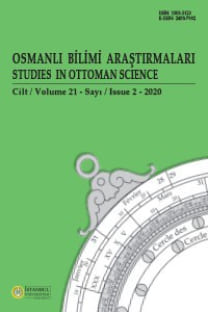Anadolu Kültüründe Kilit (Doğu Ve Güneydoğu Anadolu Örnekleri)
Doors allow for opening between spaces, interior and exterior whereas door locks provide privacy and seclusion. A lock is a particular mechanism and a functional part of the door. Doors without locks serve for separation, but it is the lock or padlock which signifies posession. By definition, a lock is a shutting device working with the help of a part that can be installed and removed, such as a key or a button.Apart from its protective features, a certain type of lock is important in providing information about the sociological and cultural modes in a given period. In Anatolia, locks from the eastern and southeastern regions, presented in this article, carry simple mechanisms, mainly becuse the community did not demand complete isolation. Interdependence and collaboration typical of nomadic society was widespread in this part of the country for a very long period. Sophisticated locks were unnecessary in this setting. Different mechanical locks, however, with elaborate mechanisms were produced to display mastery, but these were not for common use.
Anahtar Kelimeler:
Anahtar, kilit, asma kilit, Anadolu, kapı
The door lock in Anatolian culture
Doors allow for opening between spaces, interior and exterior whereas door locks provide privacy and seclusion. A lock is a particular mechanism and a functional part of the door. Doors without locks serve for separation, but it is the lock or padlock which signifies posession. By definition, a lock is a shutting device working with the help of a part that can be installed and removed, such as a key or a button.Apart from its protective features, a certain type of lock is important in providing information about the sociological and cultural modes in a given period. In Anatolia, locks from the eastern and southeastern regions, presented in this article, carry simple mechanisms, mainly becuse the community did not demand complete isolation. Interdependence and collaboration typical of nomadic society was widespread in this part of the country for a very long period. Sophisticated locks were unnecessary in this setting. Different mechanical locks, however, with elaborate mechanisms were produced to display mastery, but these were not for common use.
___
- Bir, A., Kitab al-Hiyal’ of Banu Musa Bin Shakir, Studies and Sources on the History of Science, Series No.4, IRCICA, İstanbul 1990.
- Bir, A., Kaçar, M. ve Saraçoğlu, S., “Antik dönem, Ortaçağ ve günümüzde kilit ve anahtar,” II.Türk Bilim ve Teknoloji Tarihi Kongresi, Isparta 30-31 Ekim 2006 (basılmamış bildiri).
- Dünyada Van, Sayı 24, Van Valiliği yay, Van 2006. Günay, R., Türk Ev Geleneği ve Safranbolu, Yapı-Endüstri Merkezi yay., İstanbul 1999.
- Saraçoğlu, S., Kilit ve Anahtar Türlerinin Matematiksel Modellemesi. Yayınlanmamış Doktora Tezi, Yüzüncü Yıl Üniversitesi, Fen Bilimleri Enstitüsü, Van 2007. Türkçe Sözlük, Türk Dil Kurumu yay., Ankara 2005.
- Turan, Ş., Türk Kültür Tarihi, Ankara 1990.
- Uluslararası Siirt Sempozyumu Bildirileri, Birleşik Matbaa, İzmir 2007. Weber, R., “Güvenliğimizin mekanik bekçileri: Kilitler,” TÜBİTAK Bilim ve Teknik Dergisi, c.II, sayı 1, 1984, s. 21-22.
- http://www.antikite.com Açıklama: Resim 7, 9, 10, 11, 12, 13, 23, 24 ve 25 A.Bir, M.Kaçar ve S.Saraçoğlu‟nun “Antik dönem, Ortaçağ ve günümüzde kilit ve anahtar” başlıklı basılmamış bildirisinden; Resim 16, 17, 18, 19, 20, 21 ve 22 S.Saraçoğlu‟nun Kilit ve Anahtar Türlerinin Matematiksel Modellemesi başlıklı yayınlanmamış doktora tezinden; Resim 33, R.Weber‟in makalesinden alınmıştır
- ISSN: 1303-3123
- Yayın Aralığı: Yılda 2 Sayı
- Başlangıç: 1995
- Yayıncı: İstanbul Üniversitesi Edebiyat Fakültesi
Sayıdaki Diğer Makaleler
Hofrat Prof.Carl Haussknecht'in (1838-1903) Türkiye bitkileri koleksiyonu
Kırklareli-Demirköy “Fatih” Dökümhanesi Su Enerjisi Düzenekleri Ön Değerlendirmesi
Ankara Yüksek Ziraat Enstitüsü’nde Mülteci Bilim Adamları
Hititlerin Astronomi Bilgisine Ve Hitit Takvimine Bir Bakış
Elektrik Mühendisi Mehmet Refik Fenmen: Osmanlı’dan Cumhuriyet’e Yenilikçi ve Yorulmaz Bir Aydın
Tersâne Hendesehânesi’nden Bahriye Mektebi’ne Mühendishâne-İ Bahrî-İ Hümâyûn
Prof. Kurt Krause'nin (1883-1963) Türkiye Florası İle İlgili Gezilerı ve Yayınları
Osmanlı Teknoloji Tarihinden Bir Kesit: Gemi İndirme Yöntemleri
